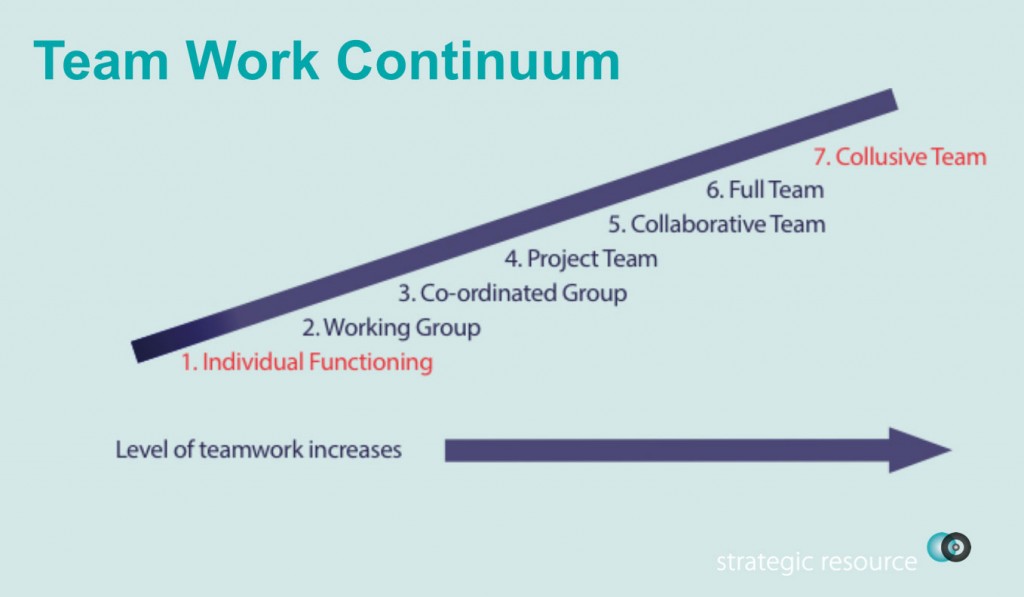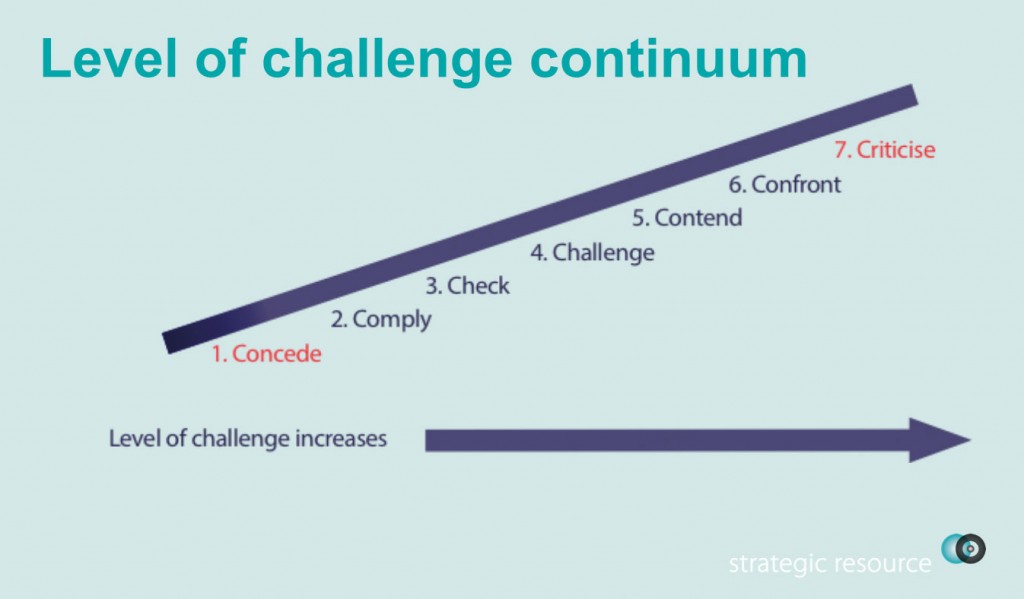Traditional team work over-emphasises the whole team approach far more than is needed for most practical purposes. In this article, John Sutherland discusses developing effective team work for senior teams.
Clare had an issue. Senior team work was unproductive but she was not sure how to resolve it to make progress. The team members were all strong characters and no one had time for any development. Too busy. Historically, when they had explored how they worked together, it opened up a whole new can of worms about how fundamentally different they were from each other. Too risky. In fact, the mere suggestion that the senior team needed developing was deemed to be mildly offensive. Too senior.
Team Development is Never an End in Itself
The senior team just needs to be able to develop and deliver their part of the business plan, and not get in the way of others who are busy delivering their part. The senior team’s job is to move the dial on performance, not to feel like they have excellent team work. So, rather than focus on team development, focus instead on supporting them whilst they are busy making progress on their key strategic drivers. No one has time for team building these days. But making team work fit for purpose whilst you crack on with delivering the plan is both efficient and effective. Efficient because it avoids taking up extra time. Effective because you develop practical forms of team work that operate well in the heat of the moment. Craft yourself an excellent “dashboard” that gives you a dynamic view of progress against plan and the stage is set to crack on with the work.
Here are four facilitative factors that we have found helpful in maintaining progress with your senior team.
1. Avoid gratuitous team work
Much of the work that actually needed to be done in Clare’s team, to make progress against plan, was best done by individuals, pairs or small groupings. Only three items needed the full team of seven to all be involved. These were setting the budget, agreeing the medium-term strategy and ensuring a consistent approach was taken across the organisation on bonus incentives. And here is an interesting point. Traditional team work over-emphasises the whole team approach far more than is needed for most practical purposes. Senior team work (meetings aside) is really a collection of sub-groupings, linked together to make the necessary progress. Mature teams slide up and down a team work continuum (see graph).
Individual functioning means that no team work is taken place. Best avoided.
A working group has a clear leader whose task is to ensure each person is focussed on the relevant tasks so that, overall, progress is made.
A co-ordinated group, in addition, ensures that the communication about these tasks is flawless, externally and internally, so that communications are consistent and no work is repeated.
A project team is formed for the life time of that project and disbands upon its completion.
A collaborative team finds that, on a routine basis, fuller team work is required to achieve the desired outcomes.
A full team is one where, like an operating theatre, it would be impossible to operate alone. There is no such thing as a lone anaesthetist. They are always part of a team.
A collusive team means that you have moved into the danger area of “group think” where individuality is stifled. Very dangerous.
When Clare first saw the level of team work continuum she let out a sigh of relief. She feared that anything focussed on team development would, inevitably, end up with them having to spend yet more time locked in a room together. Nothing could be further from the truth.
Try this fifteen minute team work exercise.
1. Write the team work continuum up on a flip chart.
2. Ask your senior team work colleagues to place their initials next to the level of team work they have observed the team using (on average) over the previous two months.
3. Discuss any clear differences in perception. Fascinating issues tend to appear when you do.
4. Ask your colleagues to place their initials next to the level of team work they think (on average) the team need to be working at in order to achieve the business plan.
5. If there is a gap between the two sets of scores, talk in detail about the practical differences in team work that these scores indicate.
I do this exercise a lot with senior teams and this is what I find.
Most teams place themselves at 2.5 for their team work over the previous two months and say they need to be at 3.5 in order to achieve their business plan.
When asked what the practical difference will be it translates into more intentional use of each other, rather than ploughing their own separate furrows.
At some point, and this is the key to this exercise, the realisation appears that the whole range is helpful. The skill is in knowing when to flex the level of team work to match the needs of the business plan.
Gratuitous team work means attempting to keep the level of team work at 4-5 all the time, irrespective of the need, and is to be avoided at all costs. Much time is wasted in business by the notion that we “must be a team”. Only be a collaborative team when you need that level of team work to achieve your strategic objective.
2. Develop your unique library of team work processes
Developing your own senior team library of team work processes is an excellent way of refining your team work, developing real ownership and increasing productivity. I wrote about this in the July-August 2015 edition of The European Business Review (pages 45-47) which you can read on-line at https://www.europeanbusinessreview.com/?p=7712. The 4 P’s save teams an average of 25% of their meeting time. If your senior team leads by example, and insists that all other teams do the same, the total amount of time saved in your organisation will be significant.
3. Resetting the team’s level of challenge
My colleague David Powell and I were working with an investment team whose performance was not where they needed it to be. They would not have invested in themselves. After running them through a team review, focussed on why a team of highly intelligent, financially literate professionals were struggling, the “culprit” turned out to be a lack of challenge. Some teams avoid strong disagreement. Other teams seem to be in constant conflict. What about your team? (see graph)
The challenge continuum is a useful yard stick for self-assessing your senior team. Just as in the fifteen minute exercise above, ask your colleagues to say where they think the level of challenge has been, on average, over the last 3 months. The difference on this continuum is that there is a preferred level. You need to be able to be at 4 (challenge) and 5 (contend) on the key strategic issues, otherwise decisions will not be robust enough. “Contending” is perhaps a word that needs unpacking. It means I have a clear view on what we should do next, and so do you. We start from the assumption that the best solution will be a synergy of both our views, rather than one person “winning the argument” or, some sort of mucky compromise. So, rather than working to pull you over onto my side, I seek to understand why you, experienced professional that you are, see it differently from me. I don’t back down from my view but I give yours a damn good listening to. And you do the same with me. If we both do this cleanly, in a distress free way, the solution that gets forged through the heat of our strong debate will be better than the one either I or you had in mind before we started.
4. Leveraging your differences
I wrote before that team work is a difference engine and divergence is the fuel. (The European Business Review January-February 2014 pages 58-60). You need individual differences to be stated clearly and cleanly to allow team work to flourish. But how do you understand the differences between you? Some are obvious. She is an accountant. He is an engineer. Others are more hidden, but equally telling, and have been hard-wired into us through our nature and then reinforced by our experience (nurture).
At the senior team level there are three that are crucially important.
The first is the different way people gather information, in order to make a decision. Just over half of us like to get into the details and consider what is happening right now. Before we can think about future strategy we need to develop the case from the ground up, making sure each step builds on the last. The rest of us prefer to stand back from the detail to see the overall pattern and conjecture where the emerging trend will take us. We let others worry about how to fill in the gaps between the current situation and our imagined future. For the “ground up” people we look as if we have our head in the clouds, talking about mere blue sky potential. For the “trend spotters” the ground up people seem like they are painfully slow and stuck in the past. Most senior team tensions are expressions of these differences in approach. Of course you need a blend of both approaches to get the best answers, but that can only happen if we see value in each other’s preferences.
The second is concerned with the approach to risk. Some of us are really good at seeing everything that could go wrong. We can instantly spot all the manhole covers left up in the road we are about to attempt to drive down. The rest of us are fantastic at finding ways around, through, over or under obstacles – once they have been pointed out to us. For us there are no problems – just opportunities in disguise. The difficulty comes when the bias is firmly towards either end of the risk spectrum, without the corrective balance. All risk and no action leads to analysis paralysis. All opportunity with no risk analysis is just asking for trouble.
The third senior team difference is about values. Values lie hidden well beneath consciousness and only bubble to the surface when someone inadvertently goes against our taken-for-granted assumption about what I think you must/ought/should do. There are a vast array of examples but one should suffice for this article. Some of us act on the assumption that in work you should follow instructions and comply. Fine to be your own boss in your leisure time but you are paid to do what you are told, so get on with it. Some of us have the exact opposite working assumption, that the only way to get the best out of people is to set them free. Tell them what they need to achieve, of course, but never cross the line of telling how to achieve it. That will simply demotivate them and suppress their creativity. Compliance versus freedom. Which side are you on? Our values are not for changing. Don’t even try. Chances are, if you are having full on conflict with a team member, and you really can’t understand why, conflicting values will be at play. Knowing your own values is an excellent starting place to monitor what presses your buttons.
Too busy? Too risky? Too senior?
Too important to leave undone, was Clare’s verdict. We all know the senior team has to lead by example. What better example can you set than developing effective team work through delivering the business plan?
About the Author
 John Sutherland is the Director of Strategic Resource, which assesses and develops senior teams in order to support them achieving their business plan. He is also the Director of the Leadership Initiative, which provides bespoke in-house programmes focussed on the specific skills required for each unique organisation.
John Sutherland is the Director of Strategic Resource, which assesses and develops senior teams in order to support them achieving their business plan. He is also the Director of the Leadership Initiative, which provides bespoke in-house programmes focussed on the specific skills required for each unique organisation.










